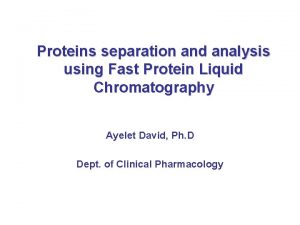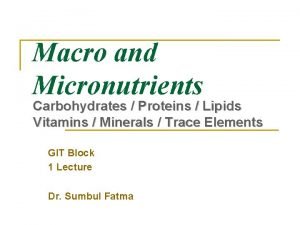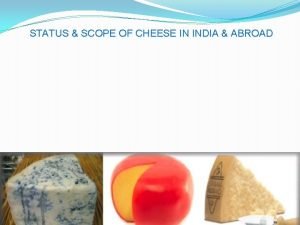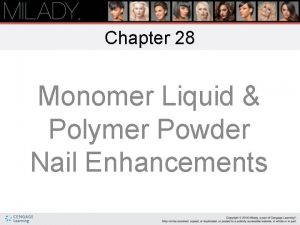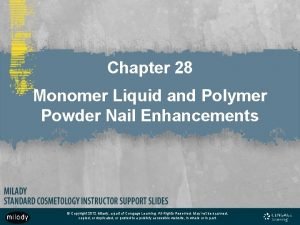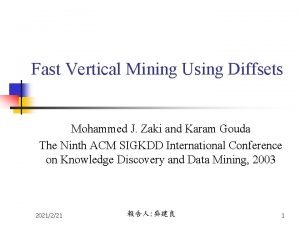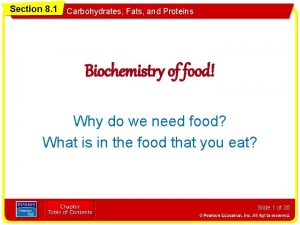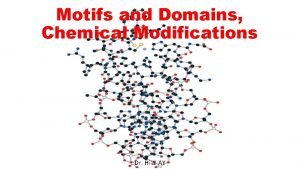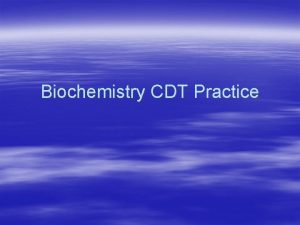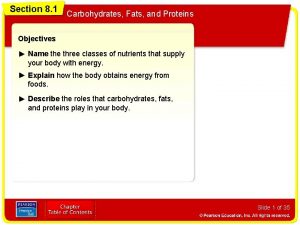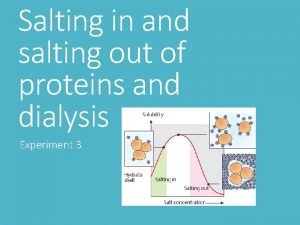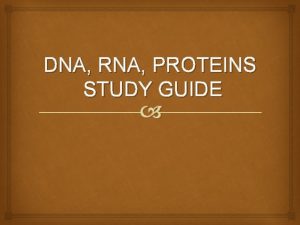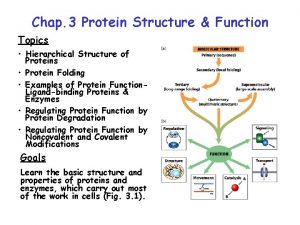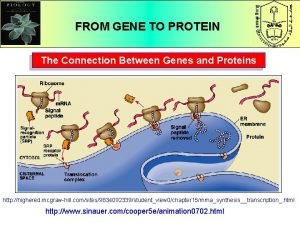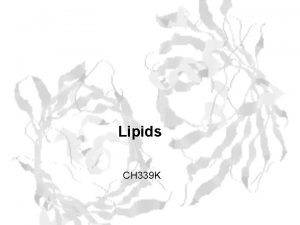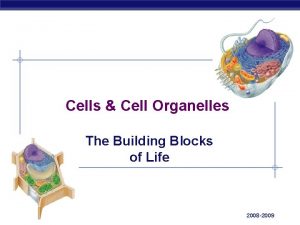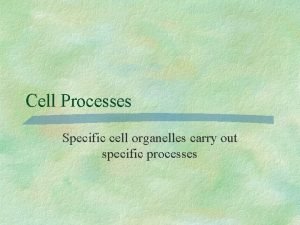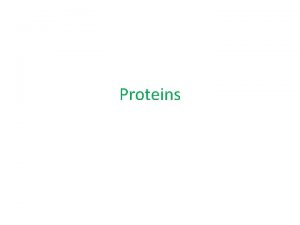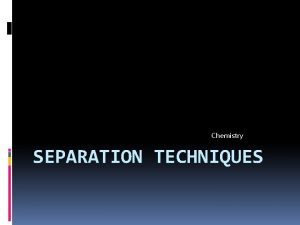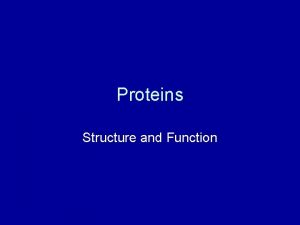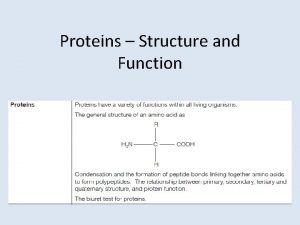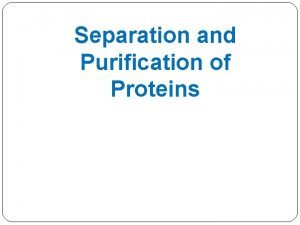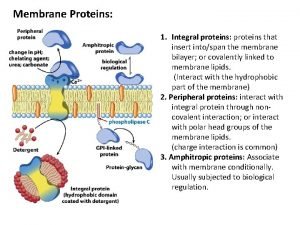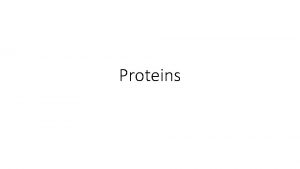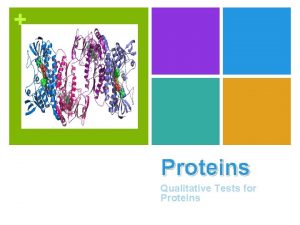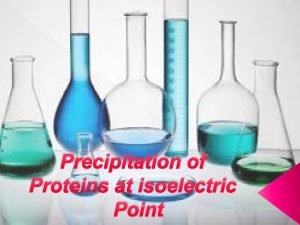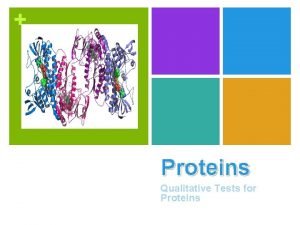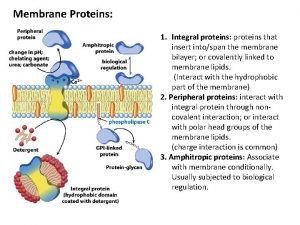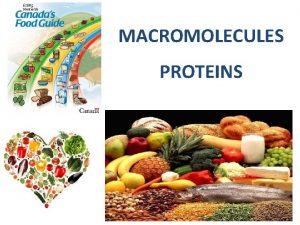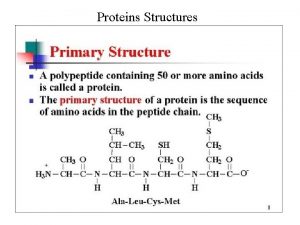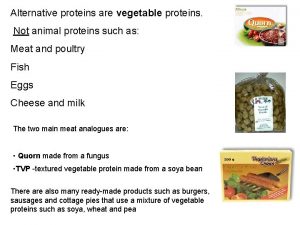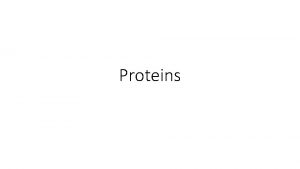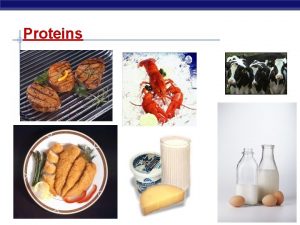Proteins separation and analysis using Fast Protein Liquid



























- Slides: 27

Proteins separation and analysis using Fast Protein Liquid Chromatography Ayelet David, Ph. D Dept. of Clinical Pharmacology

Fast Protein Liquid Chromatography (FPLC) Column chromatography used to separate or purify proteins from complex mixtures based on size, charge distribution, hydrophobicity of biorecognition (affinity chromatography). Typical columns used for protein purification, include: • Gel Filtration Chromatography — separate proteins according to their size. Also termed as “size exclusion chromatography” (SEC). • Ion exchange chromatography — separate proteins based on surface-charges. • Reversed phase or hydrophobic interaction — separates based on hydrophobicity. • Affinity chromatography — separates based on ligand affinity, such as a His-tagged protein would use a nickel column.

Gel Filtration Chromatography - Principle Molecules elute in order of size. The largest molecules come first; other molecules leave the column in decreasing order of size; the smallest ones come last.

Stationary phase: porous, cross-linked beads (dextran, agarose, polyacrylamide) degree of cross-linking determines diameter of pores and fractionation range of biomolecules of different size proteins do not attach to column pore Crossed-linked matrix

Ref: Anders S. Medin, Ph. D Thesis, Uppsala University 1995 • Scanning electron micrograph of an agarose gel, Magnification x 50, 000 • The chromatographic medium is a gel. • The gel is in the form of beads.


Biomolecules are separated according to size (hydrodynamic volume)

Separation according to size A gel beads that encloses an internal solvent space. Smaller molecules (red) can freely enter the internal solvent space of the gel bead, whereas larger molecules (blue) are too large to penetrate the gel pores.

Terms and explanations Vo= Void volume Ve = Elution volume within the separation range of the gel Vi = Inner pore volume = Vc - Vg - Vo Vc = Total (geometric) volume of the column Vt = Total volume of the column Void volume Vo Ve Volume of the gel matrix Vg Vo Vt Pore volume Vi 1 2 3 Vc 9

The void volume Vo Concentration Elution volume for very large molecules, Vo Vo Ve Volume All molecules larger than the largest pores will elute together at the void volume. Ve = V o For most gel filtration columns, the void volume represents 30 to 40 % of the total column 10 volume Vc.

Vt and Vc Concentration Elution volume for very small molecules, Vt Geometric volume of the gel bed, Vc Vo Ve Volume Vt Vc The volume in which a small molecule elutes from the column is Vt Vt = V o + V i 11 Vt is slightly smaller than Vc.

The distribution coefficient, Kd Kd = the fraction of the stationary phase which is available to a given solute. It depends only on the gel and the size of the solute. Kd is difficult to get because Vi is difficult to measure 12

The coefficient Kav Since the Vi is difficult to measure, it is usual to substitute the term (Vt-Vo) for Vi in the partition equation and call the result Kav instead of Kd. Kav is easy to get and it is more useful in practice Kav is not a true partition coefficient 13

Kav for very large and very small molecules 14

Concentration Kav should always be in the range 0 to 1 Elution volume when Kav = 1 Ve Elution with Kav > 1 Adsorption has occurred Volume Vt 15

Some typical applications for gel filtration 1. 2. 3. Group separation: Desalting, Buffer exchange, Removing reagents Purification of proteins and peptides: complex samples, monomer/dimer Estimation size & size homogeneity

Application 1 - Desalting and buffer exchange (Sephadex G-25) Sephadex G-25 is widely used for these applications. Its separation range makes it suitable for group separations work, such as the removal of salt contaminants from molecules larger than about 5, 000.

Application 2 - Purifications of proteins A gel filtration column with two different size molecules applied. The larger molecules exit the column first

Separating dimer and oligomers from monomer

Application 3 - Determination of molecular weight There is a sigmoidal relationship between Kav and the logarithms of the molecular masses for molecules of similar shape. Over a considerable range, a linear relationship exists.

• A selectivity curve is fairly linear between Kav values of 0. 1 and 0. 7 • The molecular weight range which lies between these values is defined as the useful fractionation range of the medium.

The exclusion limit is the molecular weight of the smallest molecule which cannot enter the pores of the matrix. It is an extrapolated value defined by convention.

Gel matrix has optimum ~ linear range

AKTAFPLC System A seven port motorized valve, used for sample application On line monitor offering the possibility to measure UV conductivity, and p. H. Syringe pump producing accurate, reproducible, pulse free flow rate and a precise gradient formation Injection valve INV-907 Column Fraction collector UV detector Column is easily placed on the outside of the system Mixer M-925 A single chamber mixer, powered and controlled from Pump P-920 All instrument settings and functions are under the direct control of UNICORN, a real-time control system.

All data from a run, including running conditions, method and start protocol, and a complete log of every event during the run, are automatically stored in a single file.

Efficiency is governed by the separation medium, how well the column has been packed, and the running conditions. Selectivity is governed almost entirely by the separation medium itself, so choosing the right medium is essential to obtaining the right selectivity for a given separation

 What is void volume in gel filtration
What is void volume in gel filtration Example of acid-fast bacteria
Example of acid-fast bacteria Example of acid-fast bacteria
Example of acid-fast bacteria Protein separation techniques
Protein separation techniques Example of pure liquid dielectric
Example of pure liquid dielectric Protein pump vs protein channel
Protein pump vs protein channel Protein-protein docking
Protein-protein docking Protein sparing modified fast
Protein sparing modified fast Cheddar cheese in india
Cheddar cheese in india Lever arm rule liquid liquid extraction
Lever arm rule liquid liquid extraction When using monomer liquid and polymer powder, you:
When using monomer liquid and polymer powder, you: Monomer liquid and polymer powder nail enhancements
Monomer liquid and polymer powder nail enhancements Advantages of size reduction is
Advantages of size reduction is Mohammed j zaki
Mohammed j zaki Section 8-1 carbohydrates fats and proteins answer key
Section 8-1 carbohydrates fats and proteins answer key Protein domains and motifs
Protein domains and motifs Organic compounds such as proteins and starches are too
Organic compounds such as proteins and starches are too What is the difference between hbv and lbv
What is the difference between hbv and lbv Section 8-1 carbohydrates fats and proteins answer key
Section 8-1 carbohydrates fats and proteins answer key Salting out protein purification
Salting out protein purification Protein function
Protein function Dna rna and proteins study guide answers
Dna rna and proteins study guide answers Protein structure
Protein structure What is the connection between genes and proteins
What is the connection between genes and proteins Integral and peripheral proteins
Integral and peripheral proteins Peptides and proteins
Peptides and proteins Finishes sorts labels and ships proteins
Finishes sorts labels and ships proteins Integral and peripheral proteins
Integral and peripheral proteins
